Kin recognition and social consequences in a multicellular bacterium

Dan Wall, PhD
Molecular Biology Department
University of Wyoming
Abstract
A fundamental question in biology is how individual cells within multicellular organisms interact to form tissues or organs. One approach to address this complex question is to use simple model organisms that exhibit many of the traits found in tissues. Myxococcus xanthus is one such model where, for instance, in response to starvation thousands of cells aggregate, move rhythmically and build fruiting bodies in which vegetative cells differentiate into spores. In M. xanthus we discovered a novel platform that cells use to mediate social interactions. This behavior involves kin recognition in which cells identify clonemates and transiently fuse their outer membranes (OM) and exchange proteins and lipids. Recognition in outer membrane exchange (OME) is mediated by a polymorphic cell surface receptor called TraA. Only cells that bear identical or very similar alleles of traA will recognize one another for OME. The exchange of OM components can lead to beneficial and antagonistic outcomes. In genetic models we showed that OME can result in cooperative repair of damaged cells. Here, healthy cells replenish damaged cells with missing components, which restores cell functions and viability. In other examples, OME can lead to antagonistic interactions when toxins are transferred and the recipient cell does not contain cognate immunity proteins. My seminar will discuss the molecular basis of kin recognition and how OME is used to regulate social interactions in a microbe that employs a cell aggregation strategy to build a multicellular organism.
Suggested Readings



